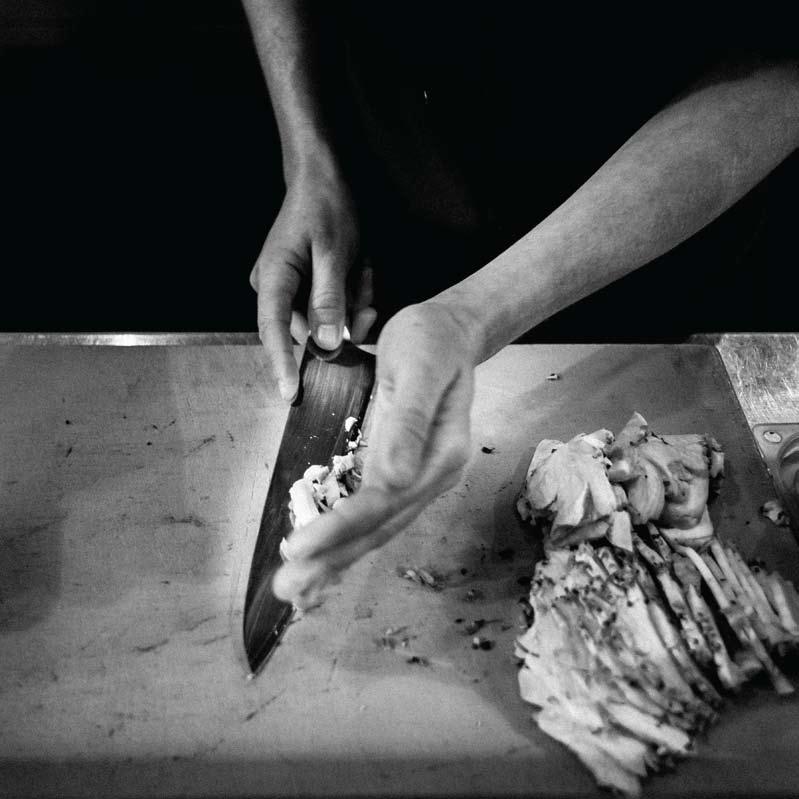
13 minute read
FOOD
Life on the Line
Advertisement
By Michael Loria and Laura Hayes
In his 27-year cooking career, Antonio Burrell has worked everywhere from retirement homes and fast-food chains to D.C. restaurants like Bistro Bis, Masa 14, Republic Cantina, and The Occidental. He’s a restless soul who frequently changes jobs and has held every position from dishwasher to line cook to executive chef. “I’ve never wanted to do anything else,” he says. “I love my job.”
But for the past year, fear has extinguished Burrell’s unconditional love for his profession. “I’m not ready to die,” he says. The chef has diabetes, and his lungs are compromised from smoking and bouts with bronchitis. His underlying conditions increase his risk of severe illness from COVID-19, which is responsible for 465,000 reported deaths in the U.S. as of Feb. 9.
Burrell is currently opening a restaurant in Maryland; working didn’t feel like a choice after facing eviction in January. If he coughs once, he panics. “I live with that fear every day I go to work,” he says.” You can’t stay home because there’s pressure to pay bills. You have to live your life, but living our life could cost you your life.”
While Burrell fills more managerial roles in kitchens at this point in his career, he’s right to be afraid, especially for the cooks in his charge. A University of California–San Francisco study published last month found that cooks had the highest proportional increase in risk of mortality during the pandemic than any other profession, including health care workers. Researchers used occupations listed on death certificates. Between March and October 2020, the number of working-age cooks or food service workers who died in California was 60 percent higher than it would have been in a normal year.
“It’s individuals in low-wage essential jobs, such as cooks, who have suffered the highest relative increases in mortality associated with the pandemic,” says AliciaRiley, a postdoctoral scholar in epidemiology and biostatistics and one of the study co-authors. She notes that executive chefs are excluded from the category of “cook.” Farmers and bakers were also in the top five. “Our policies have treated their labor as essential but not their lives. These were preventable deaths.”
There’s been discourse about the safety of restaurant workers during the pandemic, but the focus has largely been on the difficulties servers and bartenders face as they interact with diners who don’t always adhere to COVID-19 protocols. Burrell says that risk trickles into the kitchen: “You have customers coming in who don’t want to be told what to do. They’re having interactions with the front of house, who have interactions with us.”
A confluence of other factors also put cooks at risk for contracting COVID-19. City Paper spoke with several cooks about the past year. Some asked to be identified by their first name only or by a middle name. In addition to fearing for their health and safety, cooks have struggled to feel any sense of job security and the joy of their daily work has been stripped away as dining rooms emptied out and owners cut costs to stay in business. Restaurant owners dedicate more space to the dining room than the kitchen for a simple reason: Every table represents a revenue-earning opportunity. That’s how cooks wind up working in hot, crowded spaces. “What square footage you get, you have to cram in equipment and cooks to make food to make profit,” Burrell says. “You’re working shoulder-to-shoulder with people plating food, breathing on each other, sweating on each other. It’s not the most sanitary conditions, even in the best of times.”
While many restaurants have scaled back their labor forces during the pandemic, others haven’t—if the demand is there. “When you’re working in a kitchen, especially a restaurant that’s still busy, it’s a blessing and a curse,” Burrell continues. “You have people there to help you, but you’re working a lot closer together.”
“More than half of restaurants in this city are surprisingly small for the cooking space,” says Zach Ramos, echoing Burrell. He worked as a sushi chef at Sushi Taro for four years before starting a Japanese catering company with his business and romantic partner Amy Phan. “It’s hard to stay socially distant. I’ve worked in dozens of restaurants. There’s no such thing as social distancing.”
And while D’Angelo Mobley says cooks wear their masks even when it’s uncomfortable, he’s still not convinced perfect compliance will protect him. Mobley landed his first restaurant job at Carolina Kitchen in Maryland in 2011. He didn’t like that servers had to greet customers with a cheerful “welcome welcome welcome,” so he angled for a kitchen position. Since then, he’s cooked at Maketto, American Son, and Shibuya Eatery. He also left restaurants mid-pandemic to start a wing catering company.
“Picture wearing a mask on a regular day, but standing over a wok that’s 700 degrees,” Mobley says. “It’s unbearable. Even though we wear masks in the kitchen, people have outside lives. If someone has COVID and you’re with them 12 hours a day six days a week, you’re going to come in contact with them. There are not enough precautions in the world in that environment.”
“The simple fact that anybody could have it at any given moment” haunts him, Mobley says. He worries about not being told if a coworker tests positive for COVID-19. “The protocol is you have to shut the restaurant down,” he says. “No one is realistically going to do that. You never know what somebody knows and you don’t.” (When an employee tests positive for COVID-19, restaurants are supposed to notify DC Health online. The agency then reaches out to conduct an investigation and provide recommendations on how to stop further spread.)
Building trust among employees is critical. Like starting a romantic relationship in a pandemic, you have to have faith that your new partner isn’t kissing others. “Some of my cooks like to go out, which I find to be reckless, but I cannot control what they do on their own time, unfortunately,” says DavidUzzell. The sous chef at Eat Mozzeria on H Street NE has worked as a prep cook or line cook at Marcel’s, Little Pearl, Reverie, and minibar. “I can only hope that they stay safe and keep me and the rest of the staff safe.”
Uzzell is deaf. He’s relied on a combination of reading lips and enlarging notes on his phone to communicate in the kitchen in the past, but since Mozzeria prides itself on hiring deaf employees, Uzzell signs with his colleagues. “Sometimes it’s difficult to pick up on nuances, so I will smize or furrow my brows to emphasize points I’m making to my cooks or to my chef,” he says. “If someone decides to take off their mask so others can see their full facial expression, we make sure to have at least six feet between us.”
He says a persistent problem within the restaurant industry is that clocking in even if you’re sick is part of the work culture. Uzzell remembers working through a bout of gastroenteritis. “There was also the time the entire line at Marcel’s caught the flu before Valentine’s Day,” he says. “We were all hopped up on Emergen-C that week.”
Burrell adds that this norm exists at most small, independent restaurants because if you go home, you don’t get paid. “It used to be that you had to be on your deathbed at the hospital or get into a car accident for you not to come to work,” he says. “I’ve worked with walking pneumonia. Is that good for anybody? No.”
The high cost of living in D.C. makes matters worse. Uzzell says cooks may commute far distances, potentially exposing themselves to COVID-19 on public transportation. Those who can afford to live closer to work often share an apartment. Each roommate may work multiple jobs to make ends meet, widening each cook’s web of potential exposure.
When Burrell worked at Vidalia, which has since closed, several co-workers shared an apartment with cooks from other restaurants. Four people resided in the living room and a family of three occupied each of the two bedrooms. That was back in 2000, but still rings true today. At the restaurant Burrell is currently opening, six cooks live together. “The chance of spreading it is high if one person gets sick,” he says. “I have to keep expressing to everyone that we have to be careful.”
On top of anxiety about catching COVID19 and transmitting it to loved ones, kitchen workers can’t count on steady employment. Owners have increased and shrunk their workforces based on fluctuating operating restrictions. When restaurants were limited to takeout, for example, many could only afford a person or two on payroll.
When María became a cook at Taqueria Xochi in November, it was her first job in seven months. She’s not alone. Between March 13, 2020 and Feb. 2, 2021, the city has received 172,716 jobless claims.
María met the taqueria’s owners when they all worked at China Chilcano. She started there as a cleaner after moving here from Mexico five years ago and worked her way into the kitchen, making salads and desserts over the course of two and a half years. The restaurant laid her off at the start of the pandemic with a couple weeks’ pay.
On occasion, workers report learning their jobs had been eliminated upon showing up for a shift. Enrique, a cook at 2Amys and a Honduran immigrant, says that’s happened to friends and family. When they came into work they were met with either, “We don’t need you anymore,” or, “Bye, there’s no more job for you.”
His phone incessantly buzzes with people looking for work. While he asks around, he knows their chances. No doubt it’s the same elsewhere as it is at 2Amys. “We have enough people, and the ones already there want more hours,” Enrique says, adding that some who reach out have been without a job for six months.
Enrique’s been at 2Amys for a decade and feared losing his job even though he makes sure things run smoothly when Chef Peter Pastan isn’t on site. “I’m not nobody’s boss,” Enrique says, “but I do have more responsibilities.”
Pastan prioritized cook safety by committing to takeout only. He installed a second pizza oven in the dining room, creating two distinct kitchens and more breathing room. “No one seems to want to talk about the way restaurants are designed these days,” Pastan told City Paper in September. “There’s no social distancing in kitchens. Boxing seven people standing next to each other in a small space all day long trying to cook, clearly that’s a bad idea.”
While Enrique says they have plenty of room to spread out, he misses seeing diners react to their Neapolitan pizzas. “You don’t get that joy,” he says, “I like cooking and I like feeding people, [I like] the joy of seeing people happy and saying thank you when they walk out.”
This sentiment is felt more acutely at restaurants accustomed to showmanship. “It’s not the same dynamic as it was preCOVID, that exchange of guests to the open kitchen,” says Jong Son, the head chef at Tiger Fork.
Son admits his cooks are scared about job security because they know restaurants are downsizing. He shakes his head as he gets into it: “It’s not just financials we’re looking [at], we’re looking at a pandemic that gets very tricky to read in terms of how much staff you can have.”
He’s scaled down his kitchen staff from 20 people to six, and says even when a restaurant can protect jobs, they can’t always give workers enough hours. An eight-hour shift can become a three-hour shift if there are fewer reservations than expected. The industry standard is to cut workers when it’s slow.
Cooks seeking employment often learn that restaurants are prioritizing rehiring the employees they laid off. They have to at first, according to a new bill the D.C. Council passed in December. “I’m looking, even for a spot as a dishwasher,” says Abel, a local cook. “But obviously they’re giving preference right now to their people, people whom they’ve had for years.”
Hearing no from hiring managers is excruciating for the District’s undocumented workers who aren’t eligible for formal unemployment benefits. Community groups have done their best to help, but cooks, many of whom send money home to their families, are left with few options.
Enrique overheard his friends talking about their stimulus checks in April. They were surprised he didn’t get one. He laughs it off, but still wishes he had a similar safety net. “There’s people who think that everyone got this help from the government,” he says. “Most of the people who work in restaurants didn’t see that.”
He adds that some of his industry colleagues could face eviction once the city’s moratorium expires. Vera, an hourly kitchen worker, is 10 months behind on rent. She’s been in the industry since moving to D.C. from Guatemala six years ago and started working part-time at Pearl’s Bagels three months ago, but fears it’s too late. “I would love to be able to say I have a stable job now, but this is a risky job,” she says while holding up a rent due notice. “The majority of people have too few hours, and I know I expose myself and expose my family, but there’s no other solution.”
Maríaand her husband exhausted their savings between March 2020 and late fall. While they both found jobs, María says she understands the pressure other workers unable to receive unemployment benefits face. “People won’t leave work, won’t say they’re sick, or [won’t] say they were in contact with someone sick.”
She can’t help but notice the disparity between undocumented workers and those eligible for unemployment benefits. Both have bills to pay. “I wish we could stay in our house with our families,” she says. “If we want a future in this country, at what price are we going to obtain it?”
The pandemic could be an opportunity to hit the reset button. Cracks and inequities in work culture exposed over the past year formed long before the first case of COVID-19 reached the U.S. Cooks hope the pandemic brought the importance of health and safety into focus for employers who might consider offering better benefits once restaurants recover.
“I hope the industry becomes up to a standard where everyone gets paid vacation and sickdays,”Burrellsays.“It’ssomethingweneed that’snotthenorm.Youdon’treallygetanysort of paid time off until you become a manager.”
When it comes to health insurance, the service industry has historically and notoriously been an underinsured sector. Only restaurants with 50 or more full-time or full-time equivalent employees are required to offer affordable health insurance to their full-time employees, or face a tax penalty. Uzzell has worked at many restaurants in the D.C. area and says only two offered employer-sponsored health care or 401(k) benefits. Restaurant workers are relegated to using crowdfunding platforms like GoFundMe to raise money for medical expenses.
Above all, Uzzell wants to get the COVID19 vaccine as soon as possible. “Cooking has become one of the most lethal occupations in the last year alone,” he says. “We don’t have the luxury of being able to stay home.”






















